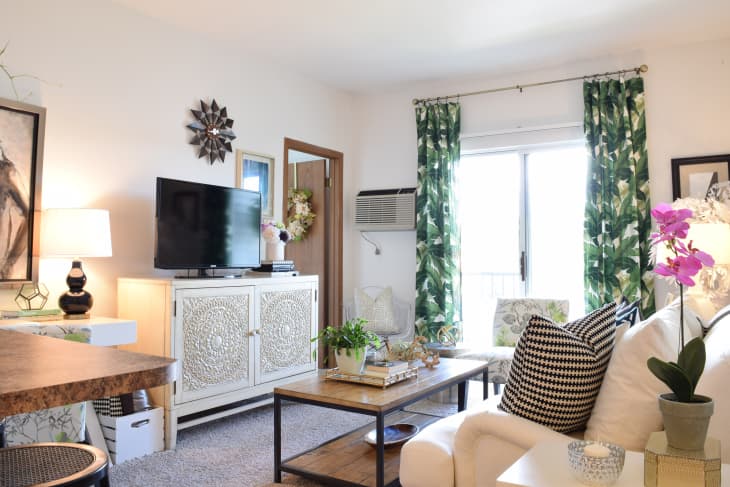Here’s What You Need to Know to Get Your Air Conditioner Size Right

I’m a huge baby about temperature, and fans sometimes just don’t cut it. So in the midst of a recent heatwave, I decided I was going to bite the bullet and get a window-unit air conditioner. But when I started researching online, I found myself confused by the various units’ cooling and efficiency numbers, with prices seemingly directly correlated with each. Given the size of my apartment, how big of an air conditioner did I need?
“Many people buy an air conditioner that is too large, thinking it will provide better cooling. However, an oversized air conditioner is actually less effective—and wastes energy at the same time,” explains the Energy Star website.
“Air conditioners remove both heat and humidity from the air. If the unit is too large, it will cool the room quickly, but only remove some of the humidity. This leaves the room with a damp, clammy feeling. A properly sized unit will remove humidity effectively as it cools.”
But before you run out and snag a small air conditioner, there are several factors worth considering. For starters, you’ve most likely seen the letters “BTU” that seem to appear in every unit’s description after sets of numbers. And you’re also probably wondering how to properly measure your room for an air conditioner (it’s not exactly as simple as measuring for a new couch).
I’ve got some helpful information on these topics, so you can be as cool as an ice cube during the most sweltering months.
What does BTU mean?
BTU stands for British Thermal Unit, and it measures the amount of heat required to raise the temperature of one pound of water by one degree Fahrenheit. According to the U.S. Energy Information Administration (EIA), one BTU is about the same amount of energy you’d get from burning a match.
You’ll use this form of measurement to match up with how much square footage is in your room, but more on that below. It sounds oddly specific (and yeah, the name’s a little weird), but knowing what BTUs are will help you find an A/C unit that’s optimal for your space.
How do I calculate the right size air conditioner?
Consumer Reports recommends 20 BTUs per square foot of the living space (or spaces) you want to cool down. But no worries about having to do any confusing equations—luckily there’s a convenient list for figuring how much A/C power you need for a room, based on the room’s square footage:
- 150 – 250 sq. feet: 6,000 BTUs
- 250 – 300 sq. feet: 7,000 BTUs
- 300 – 350 sq. feet: 8,000 BTUs
- 350 – 400 sq. feet: 9,000 BTUs
- 400 – 450 sq. feet: 10,000 BTUs
- 450 – 550 sq. feet: 12,000 BTUs
- 550 – 700 sq. feet: 14,000 BTUs
- 700 – 1,000 sq. feet: 18,000 BTUs
- 1,000 – 1,200 sq. feet: 21,000 BTUs
- 1,200 – 1,400 sq. feet: 23,000 BTUs
- 1,400 – 1,500 sq. feet: 23,000 BTUs
- 1,500 – 2,000 sq. feet: 30,000 BTUs
- 2,000– 2,500 sq. feet: 34,000 BTUs
My air conditioner was for my living room, so I measured the room with a handy tape measure. It’s not the most exact measurement in the world, but it’s close enough. My living room is roughly 330 square feet, which the chart tells me means I need an AC unit with a capacity of 8,000 BTUs per hour — which was way less than I expected.
Of course, a room’s environment doesn’t just depend upon square footage. In some cases there might be environmental issues to be aware of. For example, in very sunny rooms, you should increase the necessary capacity of an air conditioner by 10 percent. For very shady rooms, decrease it by 10 percent.
If there are often more than two people in the room, add 600 BTUs per person, or make them bring ice. If you are cooling the kitchen, remember that ovens and stovetops put out a lot of heat, and your A/C will have to compensate. Add 4,000 BTUs for any unit you install in this room. The last thing you should consider? What type of A/C unit will serve your room best.
Is a wall-through unit the same as a window unit?
Nope, these two styles of A/C are very different. If central air isn’t already built into your place, there are several cooling options, including portable air conditioners, but the two most common are wall-through and window units.
A wall-through A/C is a year-round fixture that’s installed in a customized hole through an exterior wall. Unless your apartment already has one, this option is usually better reserved for houses because it typically requires a pro to cut the wall opening. (If you do go the wall-through route, keep in mind that you need to buy a unit made for this purpose; a window A/C won’t work here.)
Window units, on the other hand, don’t require any alterations; you just need to follow the unit’s instructions for mounting it securely in an appropriate window.
Now for the fun part! To help you get started, we’ve compiled a list of the best window air conditioners that’ll help you keep your space refreshingly cool. Our picks include:
Low-Priced A/C Units
Emerson Quiet Kool 5,000 BTU Window Air Conditioner with Remote Control, $190 from Amazon
Whirlpool 5,000 BTU Window-Mounted Air Conditioner, $219 from Home Depot
Mid-Priced A/C Units
Whirlpool Energy Star 6,000 BTU Window-Mounted Air Conditioner with Remote Control, $290 from Home Depot
LG Energy Star 6,000 BTU Window Air Conditioner, $187 from Amazon
GE 8,000 BTU Energy Star Smart Air Conditioner with WiFi and Remote, $249 from Home Depot
High-Priced A/C Units
LG Energy Star 12,000 BTU Window Air Conditioner, $390 from Walmart
Frigidaire FHWC183WB2 Window Air Conditioner, 18,000 BTU, $625 at Amazon